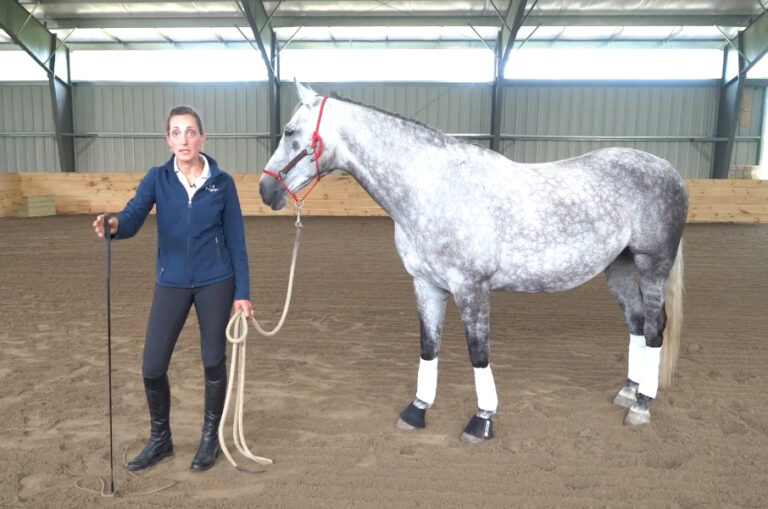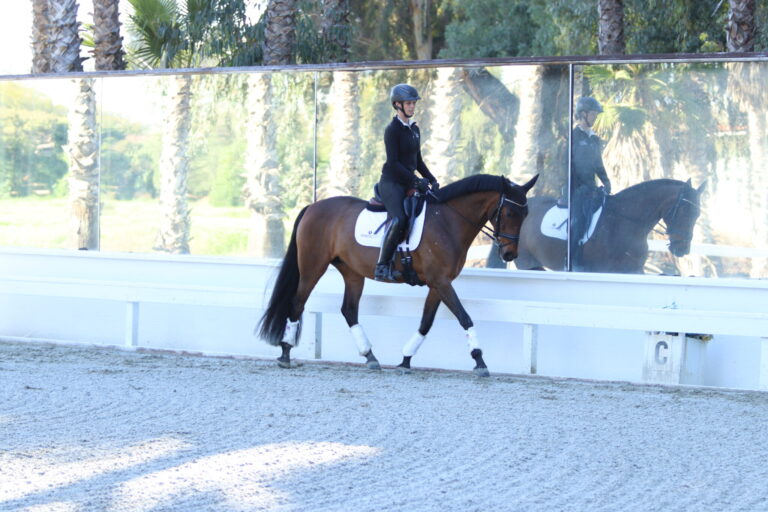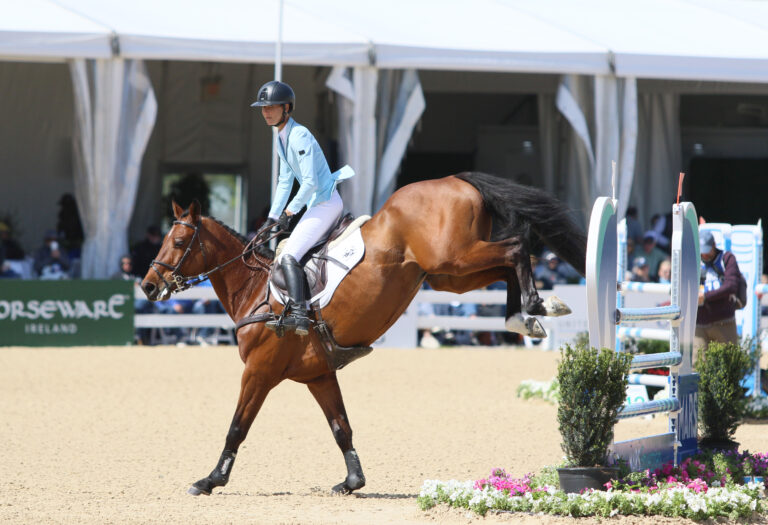My father, Reiner Klimke, always used cavalletti regularly when training his horses. Four cavalletti always stood in the riding arena so that he could use them anytime. Today, my horses also benefit from cavalletti training, which I regularly build into the gymnastic training of all of my horses. It’s a great way to maintain my event horses’ condition and agility and to build up my dressage horses’ strength all year-round.
The Advantages of Cavalletti Work for the Horse
- Improves rhythm and balance in movement
- Gymnasticizes
- Strengthens the musculature
- Loosens the muscles (especially over the back)
- Improves long-and-low stretch
- Increases suppleness
- Improves surefootedness
- Conditions
- Increases expressiveness in the gaits
- Encourages cadence
- Builds concentration
- Improves motivation through independent thought
Longeing over Cavalletti
In order to offer my horses lots of variety in their training, I longe them at least once a week. Even more valuable than regular longeing is work on the longe line over cavalletti wearing sliding side reins, which can guide the horse to go deeper.
For example, training on the longe line over cavalletti is especially valuable for schooling optimal suppleness and coordination. When trotting over cavalletti, the horse should go forward quietly but diligently and his neck should lower. This means the back is relaxed, the trot full of impulsion, the rhythm even and the horse trots up well under his center of gravity with definite lifting of the legs over the cavalletti. The circle should change often so that the horse also stays securely on the aids while he is being longed.
The transitions are the best indicator for how well the horse has remained on the aids. While on the longe, the horse must respond with precision to the aids for both upward and downward transitions. He should be calm and focused at this work. Here, too, it is important the horse is gymnasticized evenly in both directions so he becomes equally supple on both sides. Above all, effective training over cavalletti on the longe loosens the back. The horse is freed up in his movement, not carrying the rider’s weight. During this work, he has to actively think for himself. He must respond to the influence of the hand of the person doing the longeing and the driving aids (using an appropriately long longe whip is important).
When I see how cleverly and skillfully my horse negotiates cavalletti on the longe line, it provides insight into his character, which has interesting implications for his training. It’s interesting to see whether he often hits the poles or dislikes coming into contact with them, showing his level of sensitivity. Working from the ground, the person longeing sees interesting details: Longe-line training presents the opportunity to observe the horse’s facial expression, how he carries his tail, the breathing patterns at the nostril, the activity of the ears and the way all the muscles work together at all three gaits (these perspectives are more difficult to achieve from the saddle). Sometimes I become aware of certain anomalies while longeing, which I can then work through and resolve with targeted work under saddle.
Riding over Cavalletti
Cavalletti work has a physical element: strengthening the muscles while promoting cadence, increased expression, and more reliable rhythm. It also has a mental element: Cavalletti work requires the horse to think actively and to choose of his own accord to cooperate with his rider. Through this, I also manage to increase his motivation.
Likewise, as the rider, I learn to concentrate, as I must choose the right tempo and the right path through the cavalletti. Simultaneously, I need to have my horse securely on my aids.
It’s important that the distance between cavalletti in all exercises has been correctly measured, so the horse has a chance of completing the task successfully. The distance between the poles should be approximately 3 feet for walk, approximately 4 feet for trot and about 10 feet for canter.
Cavalletti on Straight Lines
Even with young horses, I begin cavalletti work at the walk on a straight line, following a lead horse. Initially, I ride over a single cavalletti, then two, three and finally four. Riding over cavalletti on straight lines develops a ground-covering, diligent and very rhythmical walk. It’s a good idea to allow a full walk stride between two sets of cavalletti. With this arrangement, the horse can rebalance a bit after the first two cavalletti before he needs to step over the next two. This exercise is also useful when multiple horses with different lengths of stride are working together: I use the middle space to add momentum for one horse, while for another, the tempo can be reduced.
On a loose rein, I ride over four walk cavalletti during the initial 10-minute stretching phase and then again in the walk break between the warm-up phase and the work phase. In the work phase, I ride over the four walk cavalletti on the longest possible rein. I can apply them very well for work on trot–walk transitions, which means I ride at the trot until I’m almost at the cavalletti, then after riding a transition with great feel down to the walk, I ride over the cavalletti in the walk.
An advanced exercise is riding at a collected walk over the cavalletti with a half-pirouette at walk, then back over the cavalletti.
Cavalletti on Bending Lines
After the horse becomes familiar with straight lines, cavalletti work on a circle at trot or canter is especially valuable, as the horse can be better gymnasticized on a bending line. Above all, exercises on bending lines are good for suppling the horse’s inner ribs and help with longitudinal bend and tracking up with the inside hand. Cavalletti training is especially useful for horses that need to step up higher and more diligently with their hind legs.
During the warm-up, I trot over the cavalletti on bending lines, allowing the horse to chew the reins from my hands as I do so. In the work phase, I ride at a sitting trot over the cavalletti and, for example, include a trot–walk transition on the side of the circle opposite the cavalletti.
I can also practice trot–canter transitions really well on the bending lines: I ride at trot over the cavalletti, then ride halfway around the circle at canter and just before the cavalletti, I transition down to trot again.
An effective exercise for more advanced horses and riders is the figure eight on a circle at the trot. Just twice over four cavalletti on the circle works wonders for the suppleness, improvement of flexion and bend and straightness and throughness of the horse. The rider trots on two circles of the same size, changing direction after each circle. Through the cones, I ride a horse-length straight ahead and reposition my horse as I do so. The goal is for both half-circles to be ridden exactly the same size and for the horse to demonstrate equally good flexion and bending in both directions.
With every change of direction, the new inside leg comes clearly into contact and drives the horse onto the new outside rein. With some horses, you really must pay attention to giving with the inside hand each time so the horse doesn’t tense up in the neck. If several rounds are successful, you can do this at sitting trot, though, of course, this exercise should not go on and on endlessly. In between, you should ride the whole arena again, using the long side to increase impulsion, preferably at the posting trot. Afterward, riding lateral movements should be considerably easier for both you and your horse.
Canter Cavalletti
There are also many interesting exercises for canter work. You can imagine that cavalletti training at canter is very demanding. Therefore, short work segments with breaks are important to avoid overwhelming the horse. Canter cavalletti on the circle are excellent for gymnasticizing, especially the inside hind, the back and the rib cage, as well as for developing longitudinal bend. In the stretching phase, I canter over them in a light seat with the horse traveling long and low; in the work phase, I sit as I canter the circle.
Trot–Canter Cavalletti
For another exercise that requires a lot of the horse, I position four trot cavalletti on one side of a circle and four canter cavalletti on the opposite side. I use cones to mark the point for the transitions. For this exercise, both horse and rider really need to already be pros at regular cavalletti work.
I canter over the canter cavalletti, transition down to the trot precisely at the cone and ride over the trot cavalletti. Then I canter with precision to the next cone. With an experienced horse, I can sit quietly through this sequence, as the horse’s back muscles are sufficiently strong. Of course, this must be schooled in both directions. It’s always important to ride proactively. You must always be looking ahead to the next cone or cavalletti. This exercise speaks to all the valuable elements of cavalletti work and trains the horse’s entire musculature. The transitions reinforce throughness with willing cooperation and precise transitions at a distinct point. Maintaining longitudinal bend and going over the eight cavalletti on the circle are real strength-builders.
This article originally appeared in the May 2017 issue of Practical Horseman and was adapted from Training Horses the Ingrid Klimke Way by Ingrid Klimke with permission of Trafalgar Square Books. Available at horseandriderbooks.com.











